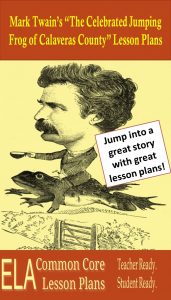The Notorious Principal of Wastemytime School District
In compliance with the request of an administrator of mine, who sent me in an e-mail, I called on good-natured, garrulous old Mr. Teachtoolong, and inquired after my administrator’s favorite writer, Leonidas W. Smiley, as requested to do, and I hereunto append the result. I have a lurking suspicion that Leonidas W. Smiley is a myth; that my administrator never knew such a personage; and that he only conjectured that, if I asked old Teachtoolong about him, it would remind him of the infamous Mark Twain, and he would go to work and bore me nearly to death with some infernal reminiscence of him as long and tedious as it should be useless to me. If that was the design, it certainly succeeded.
Mr. Teachtoolong shared with me his analysis of Realism in Mark Twain’s short stories and a Realism lesson plan for “The Celebrated Jumping Frog of Calaveras County.”
I now share it with you.
Now that you’ve suffered through my inane introduction, I’ll just give you the free lesson plan download.

Click the pic for “The Celebrated Jumping Frog of Calaveras County” unit plan.
Elements of Realism in Mark Twain’s “The Celebrated Jumping Frog of Calaveras County”
Simon Wheeler’s tales in “The Celebrated Jumping Frog of Calaveras County” are anything but realistic. Twain’s short story, however, contains many elements of Realism.
These characteristics are dead giveaways that you’re reading realism:
- Realists take their subject matter from ordinary life. Realists were influenced by the spread of democracy in Europe and North America. Middle and lower class citizens were becoming increasingly important. Detailed settings became important as a means of establishing the realistic nature of main characters and places. Dialect became popular as did an emphasis on local color.
- Realists placed an emphasis on characters. As democracy spread, so did the importance of the individual. As individuals became more important in the “real” world, characters became more important in Realist literature. Character, not plot, is the essence of Realism.
- Realists concern themselves with ethical issues. As with all literature, the conflict often involves a moral dilemma faced by one of its participants. With Realism, this dilemma has to be portrayed accurately, honestly, and in detail. Realists avoid preachiness.
Speak Your Mind